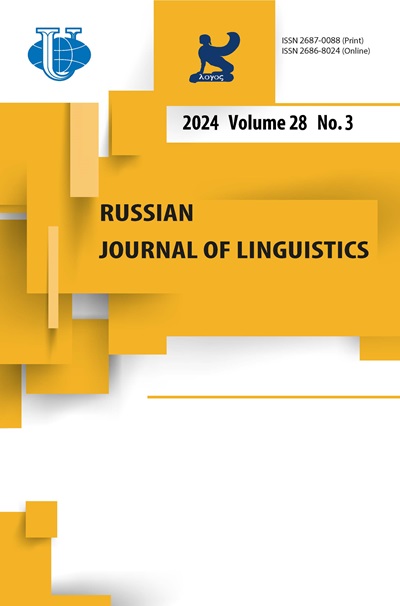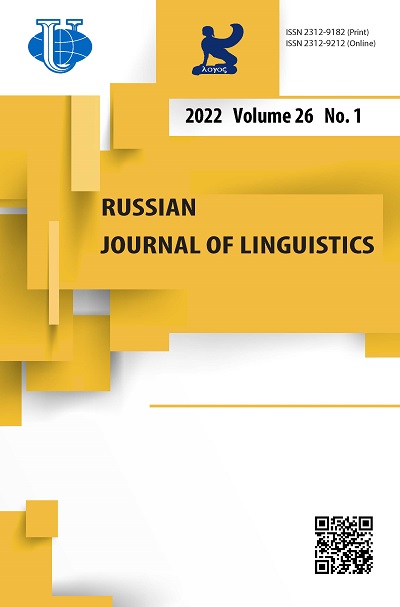Универсальные vs. культурно-специфические характеристики метафор и метонимий co значением гнева в английском и вьетнамском языках
- Авторы: Тран Б.1
-
Учреждения:
- Виньский университет
- Выпуск: Том 26, № 1 (2022)
- Страницы: 74-94
- Раздел: Статьи
- URL: https://journals.rudn.ru/linguistics/article/view/24951
- DOI: https://doi.org/10.22363/2687-0088-24951
Цитировать
Полный текст
Аннотация
Гнев как одна из базовых человеческих эмоций является объектом многочисленных исследований, позволяющих постичь особенности когниции и психологии. С точки зрения когнитивной лингвистики изучение метафор и метонимий, выражающих гнев в разных языках, может пролить свет на культурные модели соответствующих языковых сообществ. В настоящей статье рассматриваются вьетнамские и английские идиомы, основанные на метафорах и метонимиях со значением гнева, с целью выявить, как эмоции концептуализуются в этих языках и какие черты универсальны, а какие культурно-специфичны. Для анализа данных, включающих 68 английских и 52 вьетнамские идиомы, используется Теория концептуальной метафоры Лакоффа и Джонсона (1980). Показано, что в обоих языках концептуализация гнева определяется телесным опытом и культурными моделями. Выявлено шесть концептуальных метафор гнева, разнообразными способами воплощенных во вьетнамских идиомах. Культурные различия заключаются в том, что вьетнамцы часто метонимически используют наименования различных частей тела и внутренних органов, в то время как в английском языке обозначение эмоциональных состояний, как правило, основано на целостных телесных образах. Во вьетнамских метафорических и метонимических идиомах, выражающих гнев, также проявляются феодальные ценности и народная культура. Полученные результаты значимы как для лингвистики, так и педагогики. Утверждается, что в процессе преподавания следует принимать во внимание концептуальную мотивацию идиом как образных выражений, метафоричных по своей природе.
Ключевые слова
Об авторах
Ба Тьен Тран
Виньский университет
Автор, ответственный за переписку.
Email: tientb@vinhuni.edu.vn
ORCID iD: 0000-0002-3716-1137
доктор наук, доцент факультета иностранных языков Виньского университета (Вьетнам), где уже более 20 лет преподает английскую лингвистику, а также теорию и практику преподавания иностранных языков. Является членом Консультативной группы Вьетнамского национального проекта иностранных языков и рецензентом научных статей. В сферу его исследовательских интересов входят когнитивная лингвистика, кросскультурная коммуникация, а также различные аспекты преподавания английского языка как иностранного.
Вьетнам, Винь, ВьетнамСписок литературы
- Abbasvandi, Mehdi & Mojtaba Maghsoudi. 2013. A contrastive socio-pragmatic analysis of anger metaphors in English and Persian. European Online Journal of Natural and Social Sciences 2(2). 50–58.
- Athen, Gary. 1998. American Ways: A Guide for Foreigners in the United States. Main: Intercultural press Inc.
- Axtell, Roger. 1998. Gestures: The Dos and Taboos of Body Language around the World. New York: John Wiley & sons, Inc.
- Barrett, Lisa F. 2017. The theory of constructed emotion: An active inference account of interoception and categorization. Social Cognitive and Affective Neuroscience 12(11). 1–23.
- Boers, Frank. 2001. Remembering figurative idioms by hypothesizing about their origin. Prospect 16(3). 35–43.
- Bui, Phu Hung. 2019. A cognitive linguistic approach to teaching English idioms to EFL students: Experimental results. 3L: The Southeast Asian Journal of English Language Studies 25(2). 113–126.
- Constantinou, Maria. 2014. Conceptual metaphors of Anger in popularized scientific texts: Acontrastive (English/Greek/French) cognitive-discursive approach. In F. H. Baider and G. Cislaru (eds.), Linguistic Approaches to Emotions in Context, 159–188. John Benjamins Publishing House.
- Ekman, Paul.1999. Basic emotion. In Tim Dalgleish and Mick Power (eds.), Handbook of Cognition and Emotion, 45–60. New York: John Wiley and Sons.
- Ekman, Paul. 2003. Emotions Revealed. New York: Henry Holt and Company.
- Feldman, Jerome A. 2006. From Molecule to Metaphor: A Neural Theory of Language. The MIT Press.
- Gallois, Cynthia & Victor Callan. 1997. Communication and Culture: A Guide for Practice. England: John Wiley & Sons.
- Geeraerts, Dirk. 2002. The interaction of metaphor and metonymy in composite expressions. In René Dirven & Ralf Pörings (eds.), Metaphor and Metonymy in Comparison and Contrast, 435–465. Berlin: Mouton de Gruyter.
- Hoàng, Trọng Quang. 2008. Y học cổ truyền, Nhà xuất bản Y học/Hoang Trong Quang. Traditional Medicine. Hanoi: Medicine Publishing House.
- Hofstede, Geert. 1991. Cultures and Organizations: Software of the Mind. London: McGraw-Hill.
- Keysar, Boaz & Martin B. Bly. 1999. Swimmers against the current: Do idioms reflect conceptual structure? Journal of Pragmatics 31(12). 1559–1578.
- Kövecses, Zoltán & Péter Szabó. 1996. Idioms: A view from cognitive linguistics. Applied Linguistics 17. 326–355.
- Kövecses, Zoltán. 2000. Metaphor and Emotion: Language, Culture, and Body in Human Feeling. Cambridge: Cambridge University Press.
- Kövecses, Zoltán. 2002. Metaphor: A Practical Introduction. USA: Oxford University Press.
- Kövecses, Zoltán. 2005. Metaphor in Culture: Universality and Variation. Cambridge: Cambridge University Press.
- Lakoff, George & Mark Johnson. 1980. Metaphors We Live By. Chicago: University of Chicago Press.
- Lakoff, George. 1987. Women, Fire, and Dangerous Things: What Categories Reveal about the Mind. Chicago: University of Chicago Press.
- Lakoff, George & Zoltán Kovecses. 1987. The cognitive model of anger inherent in American English. In D. Holland & Q. Naomi (eds.), Cultural Models in Language and Thought, 195–221. Cambridge: Cambridge University Press.
- Lakoff, George and Mark Turner. 1989. More Than Cool Reasons. Chicago: University of Chicago Press.
- Lakoff, George. 2008. The Political Mind: Why You Can’t Understand 21st Century Politics with an 18th Century Brain. New York: Viking.
- Lê, Văn Sửu. 1998. The Theories of Ying-Yang and Five Elements. Hanoi: Culture and Information Publishing House.
- Lindquist, Kristen et al. 2012. The brain basis of emotion: A meta-analytic review. Behavioral and Brain Science 35(3).121–143. https://doi.org/10.1017/S0140525X11000446.
- Liu, Dilin. 2008. Idioms: Descriptions, Comprehension, Acquisition, and Pedagogy. USA: Routledge.
- Makkai, Adam. 2003. A Dictionary of American Idioms. USA: The Barron’s.
- Matsuki, Keiko. 1995. Metaphors of anger in Japanese. In J. R. Taylor & R. E. MacLaury (eds.), Trends in Linguistics: Language and the Cognitive Construal of the World, 137–153. New York: Mouton De Gruyter.
- McCarthy, Michael & Felicity O’Dell. 2008. English Idioms in Use. Cambridge: Cambridge University Press.
- Musolff, Andreas. 2019. Creativity in Metaphor Interpretation. Russian Journal of Linguistics 23(1). 23–39. https://doi.org/10.22363/2312-9182-2019-23-1-23-39
- Musolff, Andreas. 2021. Hyperbole and emotionalisation – escalation of pragmatic effects of metaphor and proverb in the Brexit debate. Russian Journal of Linguistics 25 (3). 628–644. https://doi.org/10.22363/2687-0088-2021-25-3-628-644
- Myers, David. 1986. Psychology. New York: Worth Publishers, Inc.
- Nguyễn, Như Ý. 2002. Thành Ngữ Tiếng Việt Phổ Thông. Hanoi: Nhà xuất bản Đại học Quốc gia Hà Nội.
- Nguyễn, Như Ý et al. 1998. Từ Diển Giải Thích Thành Ngữ Tiếng Việt. Nhà xuất bản Giáo dục.
- Phạm, Ngọc Hàm. 2018. Dog” in Chinese and Vietnamese languages and cultures. Journal of Foreign studies 34(1). 59–69.
- Ross, Catherine & Kirti Nilsen. 2013. Communicating Professionally: A How-to-do-it manual. Chicago: Neal-Schuman.
- Soriano, Cristina. 2003. Some anger metaphors in Spanish and English. A contrastive review. International Journal of English Studies 3(2). 107–122.
- Spears, Richard. 2007. McGraw-Hill’s American Idioms Dictionary. NY: McGraw-Hill.
- Steen, Gerald J. 1999. From linguistic to conceptual metaphors in five steps. In Gibbs & Steen (eds.), Metaphors in Cognitive Linguistics, 55–77. Amsterdam: John Benjamins.
- Summers, Della. 1998. Longman Dictionary of English Language and Culture. England: Longman.
- Tran, Ba Tien. 2010. Teaching Vietnamese idioms to foreign students from the cognitive linguistics perspective. Vinh University Journal of Science, 2B. 55–60.
- Trần, Ngọc Thêm. 2008. An Introduction to Vietnamese Culture. Education Publishing House.
- Verderber, Rudolph F. 1989. Inter-act: Using Interpersonal Communication Skills. USA: Wadsworth Publishing Company.
- Yu, Ning. 1995. Metaphorical expressions of anger and happiness in English and Chinese. Metaphor and Symbolic Activity 10(2). 59–92.
- Yu, Ning. 1998. The Contemporary Theory of Metaphor: A Perspective from Chinese. USA: John Benjamins Publishing Company.

















